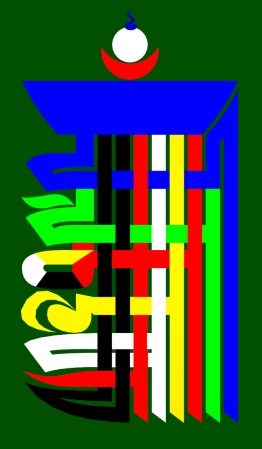April 25, 2009
She just appeared in a prolonged moment of despondency, feeling a bad case of emotional beach erosion, with only enough will left to let what ever would happen or should happen wash over me. No accomplishment or good feeling of victory ever stays with me more than a couple of hours, or has been strong enough to dispel its counterpart self-doubt. There is a long list -- which is never about who I am or what I do but what is lacking. A bill of indictment loaded to the margins with accusations, most of which I have not even heard yet. My mere presence is a trial full of nuisance and consequences for myself and others...
But then she was there, and her image threw off a soft pervasive light. There she was a golden lady and she told me her name was MA. Her name MA is not short for mother. She was not a mother-figure. She was not like my mother, nor was she anyone’s mother. That was not her identity. It was remarkable how she glowed within the dark spaces of my imagination. In fact all the illumination came from her. She reached out and I reached out, and she held onto my hand.
I don’t know what to make of her except that she was comforting and powerful. Her presence was riveting. Her hair was red and brown and golden. Her eyes were quite large and dark. Her skin was gold. She wore a full dress of some kind – it was a deep rose and embroidered richly with gold thread. She never released her eyes from my eyes, and neither did I from hers. She told me that she was not the Satguru. That the Satguru stood invisible behind her. I didn’t know what she meant. She told me that there is no need for me or anyone else to move forward or upward. It was better to remain still, to stay put, for that is where she is, and she has always been there. No need to move because she is where she is for me and everyone else. "Stay where you are. I am here always," she said.
It was given in this image that she supports the young and old, poor and rich, sick and well, deformed and beautiful, sinner and saint – that no one was too sinful or decrepit, too corrupt or too lame. She was equally there to sustain any one, and did. She was not old or young, and I would not characterize her as beautiful or ugly.
After a while I realized that she was no earth-goddess, nor of particular importance to me as a woman, yet of great importance as a human being. She was MA -- what is that? So my search for the Golden Lady MA has continued off and on whenever I had a few minutes to search, through some serious storms on my side of the universe, no matter what.
She just appeared in a prolonged moment of despondency, feeling a bad case of emotional beach erosion, with only enough will left to let what ever would happen or should happen wash over me. No accomplishment or good feeling of victory ever stays with me more than a couple of hours, or has been strong enough to dispel its counterpart self-doubt. There is a long list -- which is never about who I am or what I do but what is lacking. A bill of indictment loaded to the margins with accusations, most of which I have not even heard yet. My mere presence is a trial full of nuisance and consequences for myself and others...
But then she was there, and her image threw off a soft pervasive light. There she was a golden lady and she told me her name was MA. Her name MA is not short for mother. She was not a mother-figure. She was not like my mother, nor was she anyone’s mother. That was not her identity. It was remarkable how she glowed within the dark spaces of my imagination. In fact all the illumination came from her. She reached out and I reached out, and she held onto my hand.
I don’t know what to make of her except that she was comforting and powerful. Her presence was riveting. Her hair was red and brown and golden. Her eyes were quite large and dark. Her skin was gold. She wore a full dress of some kind – it was a deep rose and embroidered richly with gold thread. She never released her eyes from my eyes, and neither did I from hers. She told me that she was not the Satguru. That the Satguru stood invisible behind her. I didn’t know what she meant. She told me that there is no need for me or anyone else to move forward or upward. It was better to remain still, to stay put, for that is where she is, and she has always been there. No need to move because she is where she is for me and everyone else. "Stay where you are. I am here always," she said.
It was given in this image that she supports the young and old, poor and rich, sick and well, deformed and beautiful, sinner and saint – that no one was too sinful or decrepit, too corrupt or too lame. She was equally there to sustain any one, and did. She was not old or young, and I would not characterize her as beautiful or ugly.
After a while I realized that she was no earth-goddess, nor of particular importance to me as a woman, yet of great importance as a human being. She was MA -- what is that? So my search for the Golden Lady MA has continued off and on whenever I had a few minutes to search, through some serious storms on my side of the universe, no matter what.







